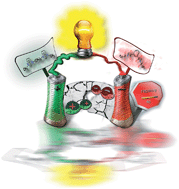Supramolecular ionic networks with superior thermal and transport properties based on novel delocalized di-anionic compounds†
Abstract
Supramolecular ionic networks based on highly delocalized dianions having (trifluoromethane-sulfonyl)imide, (propylsulfonyl)methanide and (cyano-propylsulfonyl)imide groups were developed and their physical properties were examined in detail. Most of the synthesized compounds were semi-crystalline possessing Tm values close to 100 °C; however, amorphous networks were also obtained using aromatic asymmetric dianions. Rheological measurements in temperature sweep tests at a constant frequency confirmed two different behaviors: a fast melting close to the Tm for semi-crystalline materials and a thermoreversible network for liquid transition for the amorphous supramolecular ionic networks. It was found that the amorphous ionic networks showed significantly higher ionic conductivity (10−3 S cm−1 at 100 °C) than the crystalline ionic networks (10−6 S cm−1) and previously reported amorphous citrate ionic networks (10−5 S cm−1). The supramolecular ionic networks containing hydrophobic (trifluoromethanesulfonyl)imide groups demonstrated improved water stability and higher thermal stability than the previously synthesized carboxylate ones. Noticeably, the obtained amorphous supramolecular ionic networks combine not only high ionic conductivity and thermal stability, but also self-healing properties into the same material.



 Please wait while we load your content...
Please wait while we load your content...